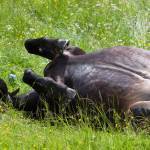Colic Signs in Horses: Know Them and React Appropriately

Horses with abdominal pain, usually referred to as colic, often display signs of distress. Like humans, though, some horses have a higher threshold for pain than others, and signs vary from horse to horse. Noticing subtle behavioral changes associated with colic will give caretakers the upper hand in overcoming colic.
Signs of colic can be lumped into five general categories.
- Restless, agitated behavior. Horses may show more or less movement in the stall than usual. While some horses will stall-walk, sometimes in circles, the more common sign is a propensity to lie down. Rolling to alleviate pain is also a familiar sign, though attempts should be made to keep the horse from rolling. Many horses will sweat, too.
- Inappetence. Changes in appetite, especially a complete lack of interest in meals, are usually a red-flag sign that a horse is not feeling well. If inappetence persists, the horse will pass less manure.
- Pain signals. Horses must express pain through behavior. Signs of abdominal pain include pawing, kicking at the belly, and staring at the flanks. Some horses will curl their upper lip in the familiar Flehmen response.
- Clinical changes. Caretakers who are well versed in taking the vital signs of horses may note that colicky horses have elevated heart and respiration rates. A horse’s gums might be dry or discolored, not the moist pinkness associated with hydration and health. Using a stethoscope, a veterinarian may also notice a change in borborygmi, or the rumbling, gurgling sounds produced by movement of ingesta through the gastrointestinal tract.
- Postural changes. Pain will often sap a horse of its natural alertness and curiosity. When in pain, horses may stand with their heads lowered, looking dull or depressed.
Owners are sometimes tempted to seek a veterinarian’s assistance only after the horse begins to show obvious pain signals, such as pawing or looking at its flanks. It is more advantageous to call a veterinarian as soon as a horse shows any of the aforementioned signs, including a reluctance to eat. The sooner intervention occurs, the greater likelihood of a positive outcome.
Some horses show frequent signs of low-level colic, and this might be associated with hindgut acidosis. For these horses, EquiShure, a research-proven hindgut buffer, will often alleviate these bouts of colic. EquiShure helps moderate the pH of the hindgut, making the cecum and colon a hospitable environment for the microbial population that resides there.








